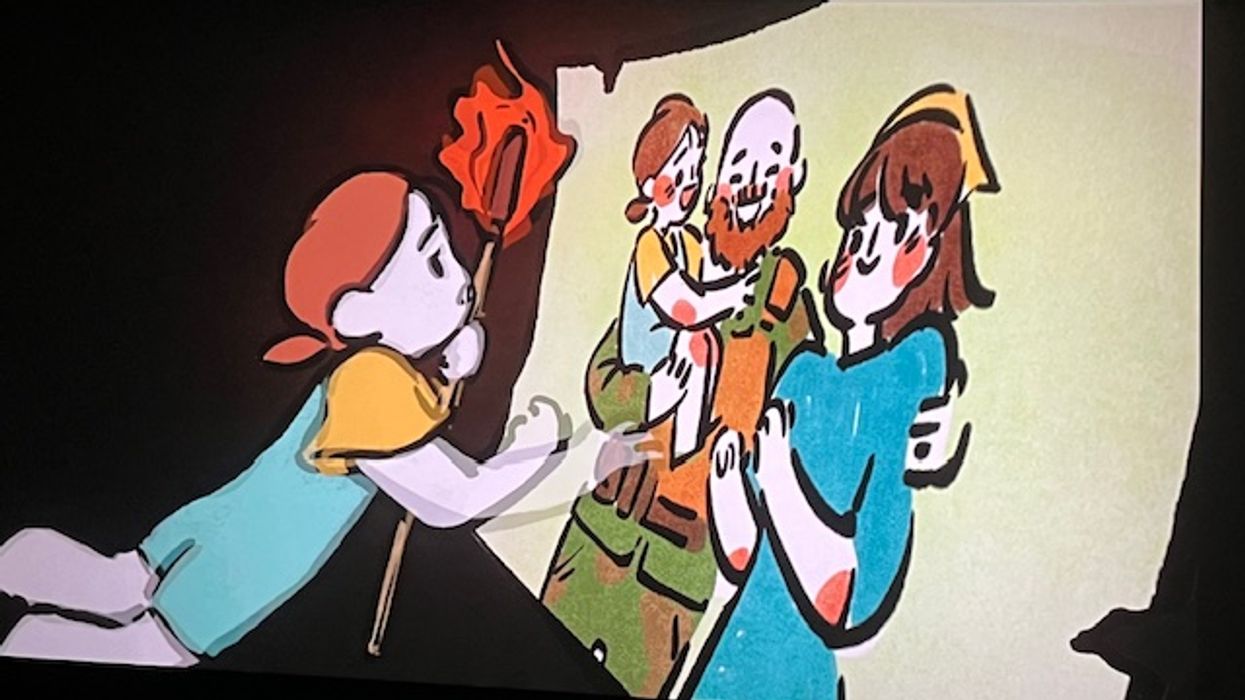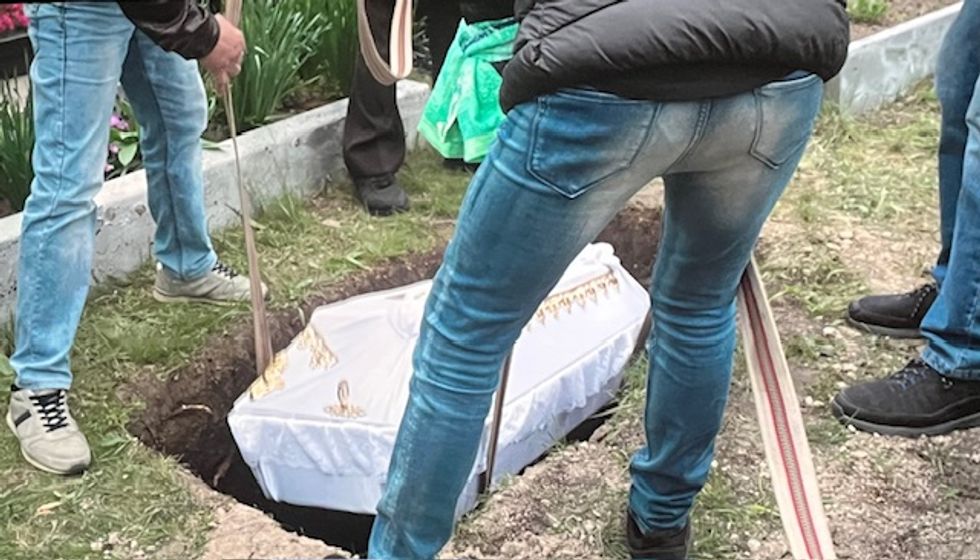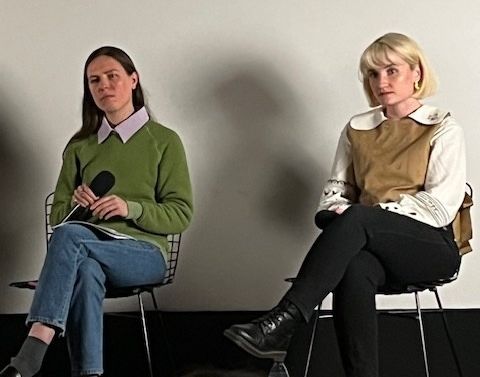Out of the mouths of Ukrainian babes

To escape the cruelties of war, Katya finds solace in her imagination in “Sunflower Field”.
Krista A. Briggs

To escape the cruelties of war, Katya finds solace in her imagination in “Sunflower Field”.
‘I can sum up the last year in three words: fear, love, hope,” said Oleksandr Hranyk, a Ukrainian school director in Kharkiv, in a February 2023 interview with the Associated Press. Fast forward to 2025, and not much has changed in his homeland. Even young children in Ukraine are echoing these same sentiments, as illustrated in two short films screened at The Moviehouse in Millerton on April 5, “Once Upon a Time in Ukraine” and “Sunflower Field.”
“Sunflower Field,” an animated short from Ukrainian filmmaker Polina Buchak, begins with a young girl, Katya, who embroiders as her world becomes unstitched with the progression of the war. To cope, Katya retreats into a vivid fantasy world, shielding herself from the brutal realities surrounding her life, all while desperately wanting her family to remain intact as she awaits a phone call from her father, one that may never come.
“Once Upon a Time in Ukraine,” a short documentary from directors Tetiana Khodakivska, Betsy West and Richard Blanshard, shares the stories of four children navigating war. Ivanna, a young girl in the Kherson region, reads from her a book as drawings of vegetables, which she has thoughtfully named, animatedly come to life on. As the film proceeds, Ivanna’s animated vegetables eventually go into defense mode against their Russian attackers.

Young Rusland from Moschun tells his story with an emotion not usually seen in school-age boys. He resides in a temporary home not far from his house, which was destroyed in a bombing. He speaks of time in the cellar, keeping busy canning food while his neighborhood was under attack. He misses his cat, Tima, another casualty of the conflict, and stays close to his dog throughout his time on camera while taking viewers on a tour of his neighbor’s former home, now a ruin from the devastation of the area. As Ruslan sadly observes, “It used to be a beauty.”
In Dnipro, eight year old Myroslava, likely a budding gymnast, is exhibiting her limberness. She speaks of formerly smooth roads in her hometown of Mariupol, which eventually caught fire. She explains, “Ukraine and Russia used to be friends until Russia got crazy.” Myroslava’s father has, in fact, perished in the conflict, but she remains in denial – or, as her mother explains, “She has gone into herself.” Myroslava finds comfort from multiple hugs from her mother, but continues to maintain her father is alive. “He will return,” she says. “He’s coming back.”
In Bucha, Maksym, 10, relates stories of explosions and bombings, as well as close encounters with missiles, which forced him and his family to evacuate. As with Myroslava, Maksym finds solace in his family, particularly his older brother. He can’t sleep in the dark and stays close to his favorite toy – a present from his mother. A pianist and a dancer, Maksym says, “I dream of peace so they don’t have to take up arms.”
Children are resilient, but the young people of Ukraine are clearly being tested to their emotional limits. When the internet cooperates, the children of war-torn Ukraine have, for the most part, been receiving educational instruction online for the past five years and despite their circumstances, are academically persevering with a strong academic focus on STEM and the arts.
But education, pets, toys and loving families are for those children who have not been killed since the war began. More than 2,000 young people have been injured or killed as a result of the conflict. Observed filmmaker Buchak, “We’re losing such a young generation now.”
The number of children who suffer from mental health challenges is much higher. Untold numbers of children are in need of psychological intervention. All of Ukraine’s children need to know the war is coming to an end, but until that day, they remain awake in a nightmare.

After the films, a Q&A featured Buchak, Anastasia Rab, chief advancement officer at the nonprofit, Razom for Ukraine, and Joshua Zeman, whose vocal talents were featured in the documentary, “Cropsey.”
“What’s going on in Ukraine is a travesty and truly undemocratic,” said Zeman, who reminded the audience that their participation in viewing these films is a form of protest against the Russian invasion, most appropriate on a day marked by protests by the Hands Off movement in support of American democracy.
Rab, whose organization supports a physically, politically and economically secure Ukraine, noted the trauma in young Ukrainians whose existence and identities are under attack. “This war is about erasing Ukraine,” said Rab, who pointed out another atrocity of war – the kidnapping, trafficking and forced illegal adoptions of young Ukrainians by Russian forces. In some instances, the young victims are “deprogrammed” by Russian forces and forced to fight against their own country – a war crime.
Despite the atrocities of war and its terrible consequences, Polina Buchak, while grounded firmly in the awful realities of the ongoing battle, remained optimistic for change. “My hope is for a peaceful sky over Ukraine without the fear of being invaded.”
Berlin High School’s football team rejoices after a last-minute win in the Class M championship game Saturday, Dec. 13.
In December’s deep freeze, football players showed their grit in state playoff tournaments.
Connecticut Interscholastic Athletic Conference named six state champions in football. The divisions are based on school size: Class LL included schools with enrollment greater than 786; Class L was 613 to 785; Class MM was 508 to 612; Class M was 405 to 507; Class SS was 337 to 404; and Class S was fewer than 336.
Eight teams qualified for each tournament and all championship games were played on Saturday, Dec. 13.
Class LL was won by Greenwich High School for the second straight year. Greenwich beat Southington High School 45-6 to win the tournament. Jack Kelly rushed in three touchdowns for the Cardinals and caught a fourth.
Class L was won by New Canaan High School, which completed an undefeated season. New Canaan beat Cheshire High School 34-13 for the school’s fourth-straight state title. In the regular season, New Canaan defeated Greenwich 14-7.
Class MM was won by Windsor High School, which defeated Bunnell High School 23-13. Windsor quarterback A.J. Robinson threw for 140 yards with a passing touchdown and two rushing touchdowns.
Class M was won in the final minute by Berlin High School 20-15 over Brookfield High School. The thriller came down to the wire. Brookfield went ahead with a late touchdown. Then on the kickoff that followed, Berlin’s Eli Rice ran it 80-yards to the house to take the lead with 33 seconds remaining and secure the state trophy.
Class SS was won by Daniel Hand High School, marking its 15th state title in school history. Hand defeated reigning champion Killingly High School 37-13. Killingly was previously on a 25-game win streak that stretched over two seasons.
Class S was won by Sheehan High School, defeating Northwest Catholic High School 21-7. Running back Joshua Durant ran for 215 yards and three touchdowns in the win for Sheehan, which was the first state title since 2019 for the school.
Details and photos from each championship game can be found at ciac.fpsports.org
Volunteers scan snowy treetops during the Trixie Strauss Christmas Bird Count in Sharon. Teams identified more than 11,400 birds across 66 species.
SHARON — Birdwatching and holiday cheer went hand in hand for the Trixie Strauss Christmas Bird Count on Sunday, Dec. 14, with hobbyists and professionals alike braving the chill to turn their sights skyward and join the world’s longest running citizen science effort.
The Christmas Bird Count is a national initiative from the Audubon Society, a globally renowned bird protection nonprofit, that sees tens of thousands of volunteers across the country joining up with their local Audubon chapters in December and January to count birds.
This wintry avian census, which is now in its 126th year, is very effective at amassing bird quantity and species diversity data, especially in colder climates where seasonal populations of birds are highly variable. These datasets, Audubon has upheld, provide vital snapshots of population health and trends, which then informs conservation strategy.
Sharon Audubon helped to host the Trixie Strauss count, the formal name of the regional count that covers an area centering on The Hotchkiss School, with staff members aiding 24 volunteers spread out over eight teams that each surveyed a unique 15-mile loop.
According to the total tally, the volunteers had identified over 11,400 birds spanning 66 species, just one less than last year’s total of 67 species.
While the number is similar, Bethany Sheffer, volunteer coordinator and naturalist at Sharon Audubon, said the species that are present are subject to change based on a number of factors. The early freeze of lakes and ponds in the Northwest Corner meant that there were fewer species that prefer open water tallied this December, Sheffer explained.
Belted kingfishers, for example, were entirely absent from the count.
The data also found no northern mockingbirds or gray catbirds. Several groups noticed an abundance of the dark-eyed junco, though Sheffer noted that the reasons for these changes from previous years are as of yet unclear.
However murky the causes, Sheffer noted that the amassing of this data lays the foundation for vital observations surrounding species trends. Citizen science observations enabled scientists to discover that the range of the northern cardinal was expanding, for example, and that the Cooper’s Hawk is becoming more common in the wintertime New England forest as it’s been staying behind to prey on smaller songbirds that congregate at bird feeders when the ground is snow-covered.
Sheffer noted, though, that it’s not all about the data.
“The history of the Christmas Bird Count is really moving,” she said, explaining that its origins lie in a Victorian tradition of a Christmas “hunt,” where groups would scour the hillsides and treetops to kill, not count.
Since ornithologist Frank M. Chapman declared the first count in 1900 as a direct opposition to the hunt, the tradition has stuck. Sheffer said it’s a valuable example of how humans’ relationship to the natural world can be reframed.
"It’s important for us now more than ever to be serving birds” as stewards, she said, noting that many species face threats due to climate change and habitat degradation and loss. And another plus, Sheffer said, is the spirit of community, bringing people of all experience levels with birds together for what she described as a truly joyous day: “It’s become an event that brings people together in a really moving way.”
The Trixie Strauss count is just one of 20 in Connecticut. Several, including one just over the border in Pawling, New York, have yet to occur. For a list of each upcoming count, and who to contact with inquiries, visit ctbirding.org/cbc-2025-2026/.
John and Diane Degnan plan to convert the warehouse at the back of the property into their primary residence, while leaving the four-unit building in the front available for long-term rentals.
KENT — A proposal to convert an old warehouse into a residence on Lane Street in downtown Kent has become more complicated than anticipated, as the Planning and Zoning Commission considers potential unintended consequences of the plan, including a proposed amendment to Village Residential zoning regulations.
During a special meeting Wednesday, Dec. 10, attorney Jay Klein of Carmody, Torrance, Sandak and Hennessey presented the proposal on behalf of John and Diane Degnan, who have lived at 13 Lane St. since 2022.
The Degnans are seeking to convert an industrial structure at the rear of their property, currently used for storage, into their primary residence, while keeping a four-unit building at the front of the lot available as affordable rental housing.
What appears to be a straightforward proposal has been complicated by a murky zoning history and regulatory constraints tied to the property’s designation.
Neighbors, however, say the review process has dragged on unnecessarily and are urging the commission to move forward with a project they believe would benefit the street.
“Is it normal for zoning to go this far?” asked Lane Street neighbor Lili Mason during the public comment period at the Dec. 10 meeting. “This is all ridiculous as far as I’m concerned.”
Mason’s frustrations were echoed by other testifiers, who voiced unified support for the Degnans’ project and praised the couple’s character:
“[They’ve] changed the neighborhood for the better,” said Ed Raftery. “Don’t penalize people who are trying to make improvements,” said Tamara Potter, another Lane Street resident, who recalled overpowering shellac fumes drifting through the neighborhood when the warehouse was used to store pleasure boats.
According to Land Use Office records, the structure has previously housed an auto body repair shop, an aquarium store, a mail-order book business, sign production and a skin care mail-order operation, among other uses.
“A commercial building on this street just doesn’t fit,” Potter emphasized, alluding to the fact that the conversion of the warehouse to a residence would essentially prohibit the possibility of a future industrial use on the property.
Commission members largely agreed with residents that the proposal — combining a new residence with affordable rentals — would be a positive change. Several commissioners, however, raised concerns about the applicant’s approach, particularly a proposed amendment to the section of regulations governing special permits in the Village Residential zone.
With guidance from zoning expert Glenn Chalder and town attorney Michael Ziska, the commission pushed back on aspects of the amendment, which would add a new section specifically addressing conversions of industrial or commercial buildings to residences. The proposed language included specialized rules related to density, parking and discretionary waivers of certain zoning requirements.
New commission member Donna Hayes, who was once the town’s land use director, explained that regulations designed for a particular project can have unintended effects elsewhere in town:
“One of the things that [residents] need to understand is that a regulation is written not for a specific piece of property but for a complete zone. And it’s written not for any particular person, but it’s written for the future as well.”
Ziska offered a similar warning: “Once regulations are changed, things happen. Things happen that nobody can expect.”
He expressed doubts about several aspects of the applicant’s proposal, though indicated general support for the concept and suggested there might be a simpler and safer way forward.
Klein said the Degnans’ goal is to improve the property “utilizing existing site resources” while bringing the entire parcel into zoning compliance. Ziska noted that the four-unit building at the front of the lot was never formally approved by a zoning officer — an issue that will need to be resolved if the units are to be used as affordable rentals. Chalder and several commissioners recommended that the applicant work with Kent Affordable Housing in coming up with a plan for the units, which Klein said would be priced between $950 and $1,800.
Klein, Chalder and Ziska ultimately agreed to meet later in the month to come up with a path forward agreeable to both the Degnans and the town. The hearing was left open, and will continue at P&Z’s next regular meeting on Jan. 8.
Students of Salisbury Central School watch ski jumpers soar during an assembly with Salisbury Winter Sports Association Wednesday, Dec. 17.
SALISBURY — Representatives of Salisbury Winter Sports Association gave a presentation at Salisbury Central School Wednesday, Dec. 17.
Former U.S. Olympic coach Larry Stone explained the fundamentals of the unique sport of ski jumping and its long history in Salisbury, where he learned to jump.
“When I was growing up here there were actually eight ski jumps just in this town in addition to the three down at Satre Hill,” he said. He noted that this winter will be the 100th year of Jumpfest at Satre Hill, named for the Satre brothers who moved from Norway in the 1920s. “They brought their sport with them and the first ski jump was actually when one of the Satres skied off of a barn roof in the center of Salisbury to show people how to do it.”
Mentioning the upcoming Winter Olympics in Cortina/Milan, Italy, Stone spoke of legendary Salisbury ski jumper Roy Sherwood who competed at Cortina in the 1956 Olympics.

Students at SCS saw videos of ski jumpers training and competing. Stone invited up students who had jumped at Satre Hill and 14 stepped forward.
One student was Aerin Sheil, who was asked what it feels like to jump: “It kind of feels like you’re flying. It’s a really good feeling.”
Gus Tripler, another student, said, “It’s like you’re suspended in the air and can see everything.”
He said his record distance of 18 meters was set in Vermont.
The student remarks gave way to closing comments that emphasized the school’s partnership with the Salisbury Winter Sports Association.
“Our partnership with SWSA is one of the most incredible things about Salisbury Central School,” Principal John Conklin said as he closed the assembly. He encouraged the students to attend Jumpfest Feb. 6 to 8.
